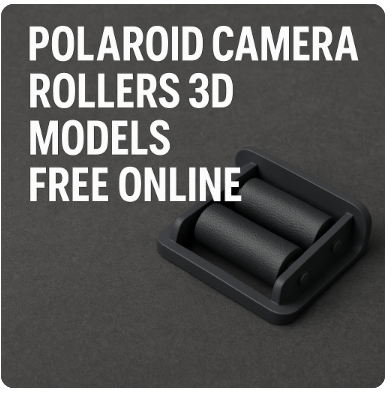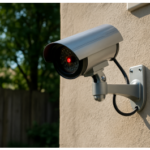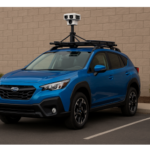Introduction to Polaroid Camera Rollers
Polaroid camera rollers are tiny cylindrical components located near the film ejection slot. They play a crucial role in pressing and spreading the film developer as the photo exits the camera. Without the rollers, the chemical spread wouldn’t be even, and the photo could be ruined.
In 3D modeling, many artists or engineers replicate these rollers for various reasons. Some do it for nostalgic camera projects, while others use the rollers for animation, repair, or realistic rendering purposes. That’s why finding Polaroid camera rollers 3D models free online has become increasingly popular.
Functionality and Design of Camera Rollers
To create or use a proper 3D model of a roller, it’s important to understand how it works. The rollers are usually rubber-coated cylinders fixed in a parallel mechanism that applies pressure to the film as it comes out of the camera body.
These rollers are designed with:
- Smooth cylindrical geometry
- Even spacing to allow film flow
- Rubber or plastic material (in the real version)
A good 3D model reflects this structure accurately, making it valuable for virtual modeling and even functional 3D-printed applications.
Best Places to Find Polaroid Camera Rollers 3D Models Free Online
Thanks to the growing digital design community, there are several platforms where you can discover Polaroid camera rollers 3D models free online. Here are some top places you should check:
| Platform | Features Offered | Model Formats | Cost |
|---|---|---|---|
| Cults3D | Vintage Polaroid models with roller part STL files | STL | Free |
| Sketchfab | Viewer-enabled models, some include internal rollers | OBJ, FBX, GLB | Free/Paid |
| Open3dModel | Clean Polaroid assemblies with exportable rollers | 3DS, FBX, OBJ, STL | Free |
| Meshy.ai | AI-enhanced models suitable for AR/VR | FBX, GLB, OBJ | Free |
| TurboSquid | High-quality Polaroid assemblies including rollers | MAX, FBX, OBJ | Free/Paid |
Some models include rollers inside the full Polaroid camera assembly. You may need to isolate the rollers using 3D editing software.
How to Download and Extract the Roller Part
When you download a full Polaroid camera 3D model, it often includes multiple internal parts. If you’re specifically interested in the roller, you’ll need to extract it.
Here’s how you can do that:
- Download the full model from any site mentioned above.
- Import the model into software like Blender, Fusion 360, or MeshLab.
- Select and isolate the roller part. Usually, these are the cylindrical parts inside the film path.
- Clean the mesh if necessary, and export it as a standalone STL or OBJ file.
- Save or modify the roller according to your needs for animation or 3D printing.
This method ensures you can get access to Polaroid camera rollers even if there is no standalone file available.
Editing & Customizing Roller Model
Once you have the roller 3D model, you may want to customize it. Editing software like Blender or TinkerCAD allows you to scale, reshape, or enhance the roller for your intended use.
Key Customization Tasks Include:
- Scaling: Resize the roller to fit custom camera builds or 3D prints.
- Material Mapping: Add rubber-like textures using UV maps for realism.
- Hollowing: Prepare the model for lightweight printing.
- Alignment Adjustments: Fit rollers into existing camera chassis accurately.
These edits let you reuse the same roller model across different Polaroid projects or creative scenes.
Usage of Polaroid Camera Roller 3D Models
There are several real-world and virtual applications for Polaroid camera rollers 3D models free online:
- Restoration Projects: Replace broken rollers with 3D-printed replicas.
- Digital Renders: Use models for hyper-realistic renders or camera simulations.
- Educational Use: Demonstrate instant film mechanisms in classrooms.
- Animation/AR/VR: Include moving rollers in immersive camera simulations.
Whether you are an engineer, 3D artist, or educator, these models can bring value to your project
Common File Types & Licensing
When you download from free platforms, you’ll usually find these file types:
- STL: Ideal for 3D printing.
- OBJ: Great for multi-software compatibility.
- FBX/GLB: Perfect for AR/VR and game engines.
Make sure to read the license terms. Most free files are for personal use, while some allow commercial use with credit.
Tips for Best Results
Here are some helpful tips when working with Polaroid roller 3D models:
- Check the roller’s size against the film slot dimensions.
- If 3D printing, test with PLA or flexible filament for better rolling.
- Use mesh repair tools to remove holes or broken edges.
- Keep the polygon count optimized for AR/VR projects.
Final Thoughts and Recommendations
Finding Polaroid camera rollers 3D models free online is easier than ever if you know where to look and what to do with them. Whether you’re recreating a vintage camera or making art, these small components can add a surprising amount of detail and functionality.
We recommend starting with platforms like Cults3D and Open3dModel for free files. Use Blender for editing and prepare models in STL for printing or FBX for digital projects.
By understanding the purpose and technique behind using these 3D models, you can elevate your design work and bring a piece of retro tech back to life!
Related Articles
Exploring Tech Vadlenix Zyrandral: A Deep Dive into His Voice in Modern Technology
NOVAtime Utah Tech: Full Guide to Timekeeping, Clock-In, and Payroll Management
Exploring Tech Vadlenix Zyrandral: Insightful Innovations in AI, Voice Technology & Future Trends


